Theoretical Foundations: Engaging Stakeholders through Network Science
Written on
In light of increasing social and physical complexities, modern urban areas underscore the urgent need for scientific methodologies that adapt to global changes and evolving urban development patterns. My thesis incorporates Stakeholder Engagement, Actor-Network Theory, and Agent-Based Modeling to determine the most effective scenarios for involving all stakeholders in Smart-City decision-making.
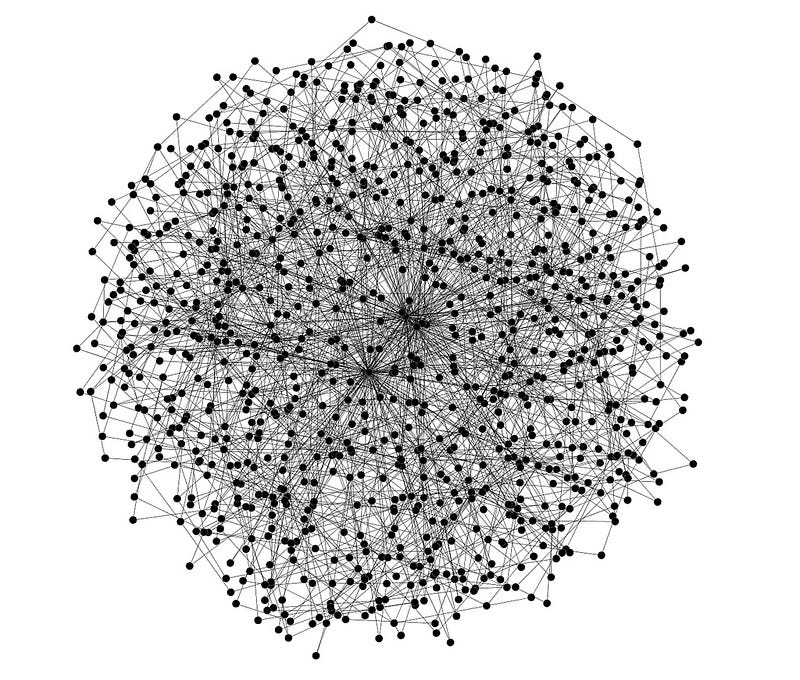
In my article titled "Civil Society: Futures of Citizenship and Democracy through Digital Perspective," I discuss a post-democracy scenario for established democracies, characterized by a citizenship crisis. Factors such as economic liberalization, new communication technologies, generational shifts in traditional politics, the rise of social networks, and growing distrust in leadership have led to a decentralization of power. This situation necessitates a rethinking of democratic principles, focusing on forming temporary consensus in decision-making processes, which increasingly complicates governance in a rapidly evolving citizenship landscape.
Utilizing Agent-Based Modeling, political scientist Robert Axelrod demonstrated in his seminal 1986 work that cooperation can emerge without centralized coordination. My research titled “Smart-City: Key Success Factors” echoes this sentiment, revealing through a study of expert urban developers from the RIL — Association of Finnish Civil Engineers that the primary objective for effective urban transformations is to engage a broad range of stakeholders.
PART 1: Fundamental Concepts of Network Science in Urban Research
Stakeholder relationships are not merely dialogues; they are interconnected. The development and reinforcement of relationships within any organization create a multiplicative value process, which is based on multi-stakeholder engagement and interconnected value creation. This process benefits not just the involved stakeholders but the entire network.
In urban transformation decision-making, stakeholders can be viewed as actors within a network who exert leadership roles in society. The shifting interests of these actors can lead to collaboration, competition, or even strong opposition as they seek to influence collective decision-making in alignment with their personal or group interests. The dynamics at play, informed by survey data collected from network representatives, will be simulated in extensive agent-based models to identify the most balanced decision-making scenarios that engage all stakeholders in urban planning.
1.1 Stakeholder Engagement
The definitions of Stakeholder Engagement (SE) and Stakeholder Integration (SI) are closely aligned: they both describe an organization’s capacity to foster collaborative relationships with diverse stakeholders. Both concepts represent "morally neutral practices" aimed at enhancing stakeholder involvement. They encompass three key dimensions:
- Understanding stakeholders and their needs,
- Interaction between stakeholders and the organization,
- The organization’s adaptive behavior in response to stakeholder demands.
These dimensions assist in assessing an organization’s level of SE and suggest a process for improvement. Scholars advocate for a cumulative approach that enables organizations to enhance their engagement capabilities, providing procedures and performance indicators for incorporating stakeholder concerns.
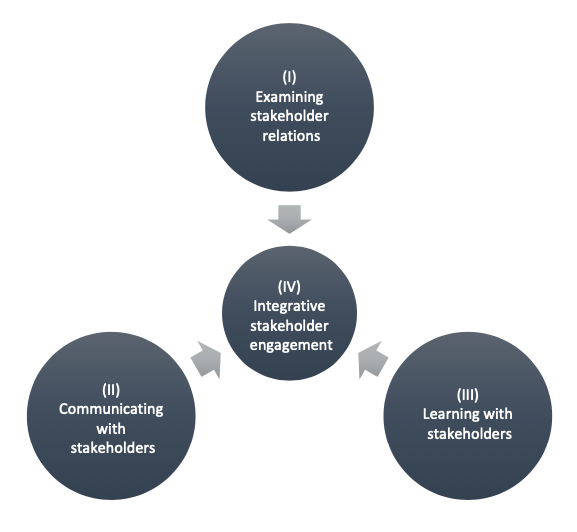
Proposed by American philosopher R. Edward Freeman in 1984, stakeholder theory asserts that companies should not solely focus on shareholders but also consider the interests of all stakeholders, including employees, customers, and the community. The importance of cooperation, relationships, and interconnections among stakeholders is emphasized, as these aspects enhance stakeholder participation in value creation. A new narrative in management is emerging, proposing that businesses aim to generate value for all constituents rather than just financial gain, advocating for a relational rather than transactional approach to business.
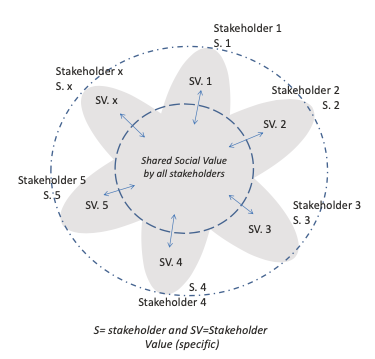
Value creation among stakeholders is an ongoing process where all contribute to the organization’s network. Consequently, as organizations enhance their overall value, they improve their survival chances and capacity to attract new stakeholders. Thus, primary and secondary stakeholders gain increased value in a multi-stakeholder framework. For value to materialize, organizations must commit to high levels of collaboration and interaction among stakeholders, while also striving to eliminate opportunistic behavior and power imbalances. Value emerges when businesses prioritize the creation of value itself, focusing on relationships and the complexities of human interaction.
Recent studies strongly advocate for exploring how organizations can implement strategic stakeholder management. Practical applications should build on existing organizational routines to refine knowledge and develop effective implementation strategies. In the next section, I will present a common model for the three cities I will examine in my thesis, aiming to apply a stakeholder management approach to actual Smart-City practices.
1.2 Actor-Network Theory
Actor-Network Theory (ANT) is a theoretical and methodological framework in social science that views all entities in social and natural contexts as part of constantly evolving networks of relationships. In this perspective, all elements involved in a social situation are considered equal, eliminating external forces that are not represented in the network. ANT values interpretative flexibility, controversy, and the roles of individuals and social groups to analyze how techniques emerge. Hence, objects, ideas, processes, and other relevant factors are regarded as equally significant in shaping social contexts alongside human actors.
This methodology is particularly relevant to my research on "Stakeholder Engagement in Smart-City," focusing on multi-actor management issues that arise from new technologies in urbanization, driven by advancements in Information and Communication Technology. The interplay between technique and society is reciprocal, blurring the lines between the two. Thus, the simultaneous development of tangible and intangible elements (social) and the coexistence of human and non-human actors within intricate networks facilitate understanding of dynamic processes.
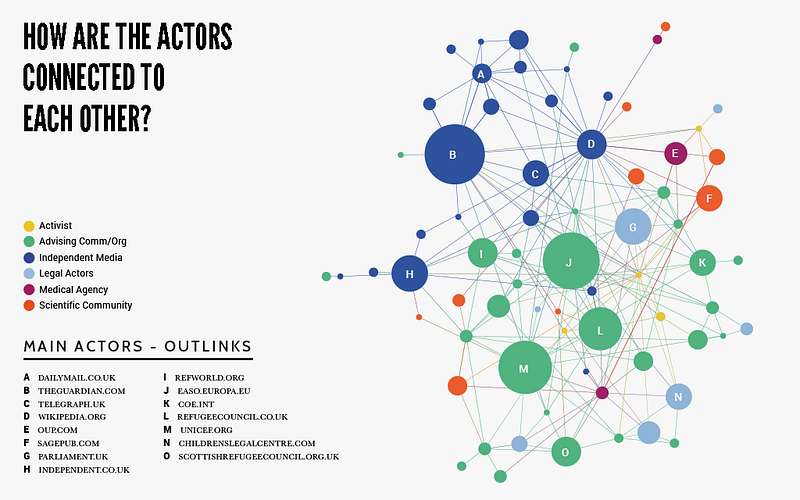
French sociologist Michel Callon has illustrated in foundational work that technical objects arise from the interests of a collective group of actors, including both human and non-human elements, along with associated hardware. This theory redefines social constructs by integrating categories traditionally seen as separate in classical epistemology, such as humans and non-humans, treating all as actors or agents in hybrid networks. Callon focuses more on the processes that yield scientific results than on the results themselves. Practically, all components of socio-technical networks intertwine without hierarchy or distinction regarding their nature, leading to the emergence of techniques through the establishment of complex networks of actors, influenced by controversies.
The ANT framework relies on several key concepts, with "Actor" being a central one. From my perspective, an actor is a human characterized by intentions and dependent on other elements that express their desires in their language. This should not be confused with "Agent," which includes both human and non-human nodes within a network. "Association" refers to the connections formed between nodes, sometimes facilitated by an "Intermediary." The "Translation" process is a three-step framework that differentiates representatives for specific actors or categories of actors, marking a crucial moment in network production. This process begins with "Problematization," where an actor defines a problem's nature in a specific context. An influential actor often shapes the identities and interests of other actors to align with their own, establishing a dependency among network agents by determining an "Obligatory passage point," which all actors must navigate to meet their designated interests. The subsequent steps in the translation process are "Interessement" and "Mobilization" (or "Enrolment"), whereby other actors accept the central actor's definitions and assigned interests before joining the network. The socio-technical construction of the network is characterized by "Controversy" among agents, another critical condition for the network, and "Negotiation," which aligns the interests within the network, culminating in a consensual technical object. This entire process leads to an "Irreversibility" state, a threshold beyond which reverting to previously available options becomes impossible.
This terminology serves to prevent assumptions regarding the "what," "who," and "how" of network formation: What or Who are the actants? How was the association formed? Who or What has been translated by Whom or to What? These questions can only be effectively answered through empirical engagement with the unfolding of an actor-network.
1.3 Agent-Based Modeling
Social sciences aim to comprehend not just individual behavior but also how interactions among numerous individuals lead to larger-scale outcomes, revealing that final results can exceed the sum of individual actions. It's often said, "Architecture, as the art of shaping public spaces, is the most political art of all." Political systems involve citizens, voters, politicians, parties, legislatures, and governments, whose interactions dynamically influence final decisions. A similar phenomenon is observable among stakeholders in urban planning decision-making. In my research, my goal is not to establish what the final consensus decision would be but rather to identify which combinations of parameters (independent variables) yield the most balanced network for leadership in urban planning. By employing Agent-Based Modeling, I aim to discover the most realistic scenario that facilitates collaborative decision-making among all stakeholders within the city's public sphere.
ABM leverages concepts and tools from both social and computer sciences, offering a methodological approach that facilitates two significant advancements: 1) a rigorous testing, refinement, and extension of existing theories that are challenging to articulate and evaluate using traditional statistical and mathematical methods, and 2) a deeper understanding of essential causal mechanisms in multi-agent systems, whose study is often hampered by artificial disciplinary divisions. ABM integrates specific properties of agents and the rules governing their interactions within a simulation, allowing observation of how these micro-level specifications can generate macro-level phenomena of interest.
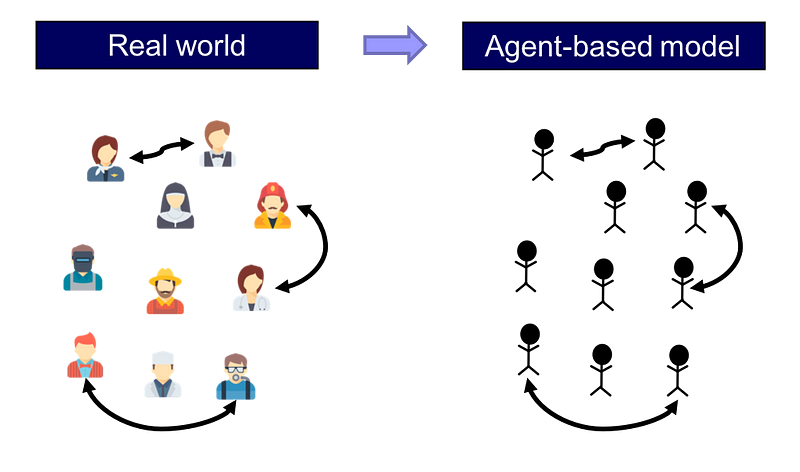
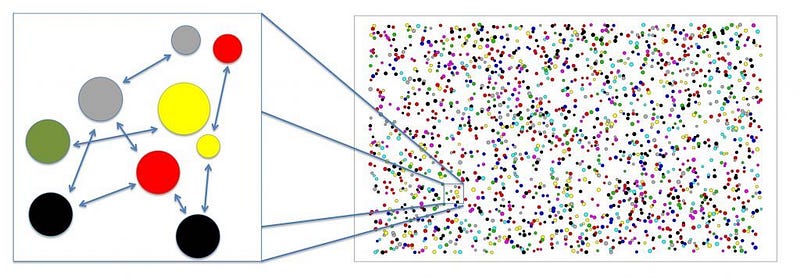
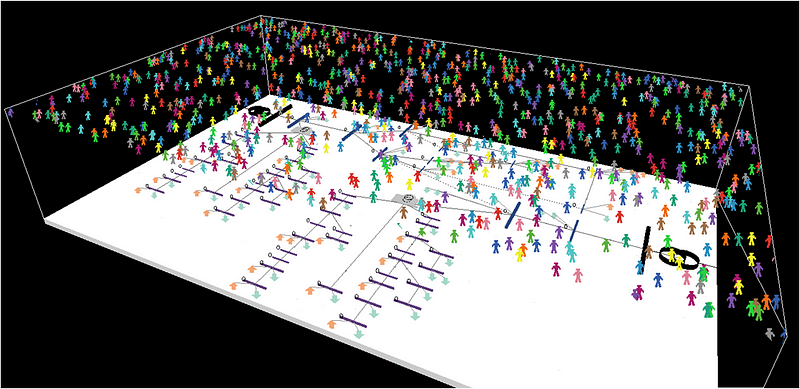
ABM posits that complex collective patterns can arise from the repeated execution of individual behaviors once the lower-level properties and rules are established in a simulation. It is particularly well-suited for studying systems that exhibit the following two characteristics:
- The system is composed of interacting agents.
- Properties emerging from agent interactions cannot simply be deduced by aggregating the properties of individual agents.
When agent interactions depend on past experiences, especially as they continuously adapt, traditional mathematical analyses become limited. ABM emerges as a practical analytic method for deriving dynamic consequences from the evolving properties of agents over time. The three critical components of ABM are agents, environment, and time.
- Agents are entities in the model possessing attributes, states of mind, and behavioral rules that influence their interactions with others and the environment. They are typically heterogeneous in attributes and states: each agent has distinct emotions, preferences, and spatial locations, yet generally adheres to the same interaction rules. Their emotions and opinions evolve through interactions with their neighbors and exposure to media messages, potentially occurring in events and clusters promoting urban transformation.
- Environment dictates whom agents interact with and how those interactions unfold.
- Time determines the sequence of interactions among agents. Advances in computing power enable synchronous state updates across agents and the entire system, which is advisable for simulation models. Most models typically initiate with a randomly distributed system state and focus on outcomes observed once the phenomena of interest stabilize or reach equilibrium.
Simulations commence with a rigorously defined set of hypotheses regarding the proposed system; however, they do not establish theorems with universal applicability. They begin with hypotheses about agents and their interactions and subsequently utilize computer simulations to generate scenarios that illuminate the dynamic consequences arising from variations in independent parameters. This contrasts with standard deduction and induction in both execution and objectives, yet it enhances understanding of systems through controlled computational experiments. Political science researchers have uncovered key aspects of ABMs in the context of decision-making, which will prove beneficial for my model:
- The likelihood of voting is influenced by the satisfaction derived from previous voting experiences. In urban planning decision-making, the most detrimental effect of civic consultation arises when the public feels unheard after investing significant time and energy in participatory events like "Imagine the Future of Your Neighborhood."
- A voter’s opinion is influenced by two emotional levels (calm and agitated) and three opinion types (pro, neutral, and contrary).
- A voter may be swayed by a randomly selected neighbor (20% chance) or media messages (80% chance).
1.4 SE, ANT, and ABM in Urban Studies
Actor-Network Theory serves as a method to map urban development processes and visualize actors and networks through diagrams, treating cities as contingent, heterogeneous, and persistent products of interactions among humans, places, and infrastructures. An iterative approach to urban development can transcend the perception of cities as mere economic, social, or cultural entities and recognize them as complex, dynamic, and borderless communicating systems. Research on Smart-Cities must consider how urban functionalities are shaped by both human actions and non-human materials, which are further influenced by the city's spatial and historical context. As highlighted in "Smart-City: Defined by Insiders" and "Smart-City: Stakeholders Roles and Needs," current trends in urban planning are heavily reliant on the emergence of new Information and Communication Technologies and the recent renewal of democracies driven by digitally literate voters. In this context, technological objects play a significant role in decision-making for urban development, acting as social intermediaries that catalyze interactions among elements of the urban system across time and space.
Networks themselves serve as active components linking urban actors, which can be mapped across spatial, temporal, and decision-making layers in urban development processes. Politically, urban development encompasses all changes to a city, including maintenance, transformations, and alterations to its original state. In a context where physical spaces continuously intertwine with social constructs, places are no longer seen as neutral material objects; rather, they represent influential "spaces of flows." Consequently, the contemporary urban landscape is shaped not solely by spatial forms, economic units, and cultural formations, but also by intricate socio-material and socio-technical systems of interactions among human, social, and technical elements. Understanding urban development phenomena can be approached in four progressive stages:
- Identifying all active elements within an urban system,
- Determining their roles and attributes,
- Investigating the associations among them (intermediaries’ configurations and translations),
- Monitoring stability and instability in actors’ associations.
The strength of the ANT approach lies in its comprehensive perspective on the active role of non-humans, enabling a holistic view of the world as a process, while establishing broad, revolutionary categories of time and space through the representation of horizontal links and associations. In addressing the issues at hand, I retain certain established concepts from urban theory and practice, yet reinterpret them using the ANT framework, clarifying the types of networks (urban assemblages) that address the dynamic social aspects of decision-making in cities.
PART 2: Practically Modeling Urban Development Dynamics
Every city possesses its unique networks of actors and agents that influence local urban planning decisions. Identifying stakeholders, actors, and agents, along with their cooperative or opposing behaviors and potential recurrent patterns, represents crucial steps in my research. The modeling of data collected from field investigations will enable me to enhance the outcomes of large-scale interactions and substantiate my hypotheses in response to my research questions.
2.1 Identifying the Operational Agents
The phenomenological approach employed in my research allows for the identification of key agents through diverse information sources, including personal web research, surveys of residents, participatory workshops with engaged individuals, face-to-face interviews with key stakeholders, and observations of relevant meetings and events during my field investigations.
The Actor-Network Theory enables me to consider each individual, legal entity (such as companies or associations), website, social media group, event, and location where network agents interact as influential components. All these agents have the potential to affect the dynamics among actors through a complex set of intrinsic properties and extrinsic motivations that drive the entire network in accordance with personal interests. The distribution of roles within the regulatory framework heavily relies on the human actors, whether individuals or groups, who assign or are assigned specific positions in decision-making. Traditionally, personal interests can be categorized into three groups:
- Top-Down Urban Planning Actors include national authorities responsible for administrative duties, governing strategic construction, site development, and infrastructure projects, as well as cities and municipalities that have the legal authority to formulate their own strategies, plans, programs, and local regulations concerning urban development.
- Interest-Based Transformations consist of influential business stakeholders and corporate entities, powerful investors who leverage their economic and political influence to acquire valuable real estate and market segments for profit.
- Bottom-Up Participatory and Urban Design Activities involve artists, cultural workers, NGOs, and associations that create alternative strategic pathways for influencing neighborhood development. On a global scale, creative clusters enhance a territory's reputation and allure.
From my previous article "Smart-City: Stakeholders Roles and Needs," I identify four categories of stakeholders in urban planning:
- Governmental & Public Sector,
- University Academics, Research & Innovation,
- IT and Construction Private Sector Companies,
- Civil Society, Social & Third Sector.
Applying the Actor-Network Theory perspective, I can recognize the following representatives as key actors in urban development decision-making:
- National Government
- Local Government
- Public Services
- Financial and Funding Partners
- Academic Research & Universities
- Private Research and Innovation
- Corporate Companies (IT or Construction Industry)
- eCommerce, Startups, Small and Medium Enterprises
- Independent Designers, Architects, or Developers
- Grassroots Movements, Local Associations, and Non-Profit Organizations
- International Non-Governmental Organizations and Third Sector
- Individual Citizens
Moreover, given the political science insights mentioned above—indicating that 80% of voters are influenced by media messages—and considering the identified astroturfing phenomenon "Citizen Identity Theft in Public Spaces and Social Networks" from my article "Civil Society: Futures of Citizenship and Democracy through Digital Perspective," along with the definition of Smart-City presented in "Smart-City: Defined by Insiders," which centralizes Information and Communication Technology (ICT) in contemporary urban development trends, I will also incorporate media as a fifth category of stakeholder in my model. Media will serve a dual role, acting as both an actor and an intermediary for many other agents. In an omni-channel approach to media, I will consider major representatives such as:
- Social Media (Facebook, Twitter, YouTube, Medium, LinkedIn, Instagram, Pinterest, Snapchat)
- Mobile Communication (Phone + Messaging Apps: WhatsApp, Telegram, Line, WeChat, Slack)
- Websites
- Email Campaigns and Newsletters
- Print Media (Books, Flyers, Brochures…)
- Newspaper Industry (Professional Journalism and Fanzines)
- Radio
- Television
Additionally, the ABM for political science discussed earlier indicates that voters' opinions on decision-making are influenced by their environment, with a 20% chance of changing their views when exposed to a neighbor with a contrary perspective. Furthermore, relevant to the advice of French geographer Pierre Gentelle, noted in "Taipei Monograph: Chinese Civilization, the Particularities of Taiwan and Taipei City," the locations where individuals interact and the events associated with them will be included in my model. These can include:
- Neighborhood associations and events
- Global promotional events (hackathons, meetups, forums…)
- Innovation and startup support structures
- Business clusters and entrepreneurial ecosystems
- Urban Infrastructure (Public Real Estate, Transportation systems, Public Sports and Leisure areas)
- City Council or other Governmental Deliberative Assemblies
- Online (web forums and applications)
For each case city, I will employ mind mapping tools to create an actor-network map in collaboration with representative local stakeholders during participative workshops and one-on-one interviews. Both quantitative and qualitative data will be collected through surveys on social networks, media, local events, and word of mouth to validate each actor's attributes. Roles, attributes, mental states, and behavior patterns for each actor/agent within the network will be identified in subsequent steps as independent variables for my simulation model.
2.2 Constructing My Model
Concrete training in Agent-Based Modeling is generally lacking in most Ph.D. programs; however, among the numerous theoretical developments, a few resources provide empirical methodologies for beginners to construct their models. In "Agent-Based Modeling: A Guide for Social Psychologists" (2016), Joshua Conrad Jackson and Kurt Gray present a seven-step guide for model creation, which I have utilized to develop mine. Below are the seven proposed steps along with my personalized responses.
- What are your world’s dimensions? Group formation models are often multi-dimensional to reflect complex social spheres, but dimensions apply only to models where agent interactions are spatially governed. In my case, even though my study addresses a spatially rooted issue (Urban Development), the network model chosen to illustrate the boundless connections and interactions among stakeholders is dimensionless.
- How do agents meet? Will interactions be random or governed by rules (or a combination of both)? Do agents only engage with neighbors or can they interact with any agent in the simulation? Can they completely avoid interactions (due to unpopularity) or engage with multiple agents simultaneously? In my case, a scale-free network is the most applicable model to depict decision-making in urban planning, where interactions are influenced by regulations but also occur randomly (especially regarding counter-powers exercised by NGOs and civil movements). Agents can interact with any other agents and can engage with multiple agents at once (in rounds), though they are more inclined to connect with "friends" than "enemies." Behavioral patterns, emotions, and opinions can shift through interactions with others and based on satisfaction derived from prior positions.
- How do agents behave? When agents meet, what actions do they take? Do their behaviors reflect the type of social behavior of interest? In my case, agents attempt to sway one another until a final consensus on the decision is reached, marked by an irreversible state beyond which alternative options are no longer feasible.
- What is the payoff? Generally, agents derive money, happiness, or social bonds from their interactions. In my model, similar to many ABMs that feature interactive decision-making, payoffs are determined by the decisions of an agent and their partner(s). Thus, the payoff for any agent will consist of the benefits gained from a final consensual decision that aligns closely with their personal interests.
- How do agents change? In many models, agents learn from past payoffs and adjust their behavior in future rounds. Some agents may "die" (exit the network, often due to low payoffs) or reproduce (attract similar agents, typically when payoffs are high). When agents form groups, their influence can either amplify or diminish. In my case, changes in behavior or opinion will be influenced by temporary opinions, affinity groups, and spatial or ideological proximity to the decision at hand. This suggests that a minority of agents will maintain consistent opinions, while a majority will frequently shift. Additionally, findings from my survey study "Grassroots Movements: The Motivation of American, Taiwanese, and Russian Civic-Hackers Compared" indicate that, particularly in civil movements, agent engagement in decision-making is contingent upon cultural and political heritage, as well as leadership management choices and personal financial aspirations.
- How long does your world last? Some models must run until they reach equilibrium, while others should operate for a duration that reflects a phenomenon of interest. In my case, the model of stakeholder engagement in decision-making should be ongoing, as democracies are endless processes of collective decision-making. However, simulation models will be constrained by computer storage and processing speeds, and the need for a conclusion in my thesis leads me to identify regular cycles (patterns) in the influence of actors on one another.
- What do you want to learn from your world? ABM represents a theory-building and hypothesis-testing paradigm that includes dependent and independent variables. Independent variables (or "parameters") are customized by the experimenter, while dependent variables are measured throughout the model or at its conclusion. Adding more independent variables to the model or employing new variables to test the generalizability of a phenomenon is known as "robustness analysis," which can unveil unexpected new effects or non-linear relationships. In my case, I aim to explore the optimal scenario for participative decision-making in urban planning, where all stakeholder opinions are considered, culminating in a consensus that minimizes short-term opposition and long-term criticism.
Conclusion
The rapid movement of people and information has profoundly transformed our understanding of space, time, lifestyles, communities, and identity. Cities are increasingly viewed not as distinct geographical entities but as concentrations of various socio-spatial circuits, diverse cultural hybrids, economic dynamism, and a complex array of interrelated processes that form a coherent and multifaceted time-space system.
The essential unifying force of the modern city encompasses technical solutions (urban infrastructures) and technologies (communication and media). In this context, social aspects (political, economic, and cultural) are regarded as contextual components of the urban assemblage, and acknowledging these factors in urban development decision-making within globalized cities presents one of the most significant challenges for urban professionals.
Bibliographical References:
- Stakeholder Engagement: Clinical Research Cases, R.E. Freeman et al. (2017), Issues in Business Ethics 46, Springer International Publishing.
- Théorie de l’acteur-réseau, Aziza Mahil and Diane-Gabrielle Tremblay (2015) in Sciences, Technologies et Sociétés de A à Z, Presses Universitaires de Montréal.
- Decoding Urban Development Dynamics through Actor-Network Methodological Approach, Marija Cvetinovic, Zorica Nedovic-Budic, Jean-Claude Bolay (2017) Geoforum 82.
- On-Line Guide for Newcomers to Agent-Based Modeling in the Social Sciences, Robert Axelrod and Leigh Tesfatsion (2019), Iowa State University.
- Agent-Based Modeling: A Guide for Social Psychologists, Joshua Conrad Jackson and Kurt Gray (2016) University of North Carolina at Chapel Hill.
- Agent-Based Modeling in Political Decision-Making, Lin Qiu and Riyang Phang (2019), Oxford University Press.
About the Author:
Julien Carbonnell: After several years as a real estate developer in Perpignan, South of France, I founded OpenPI, a startup focused on involving neighbors in local urban planning decisions. I have since embarked on international research examining "Stakeholder Engagement in Smart-Cities." The core of my methodology will involve comparing participatory decision-making strategies in three culturally diverse cities: Taipei, Taiwan (Asia), Tel-Aviv, Israel (Middle East), and Saint Petersburg, Russia (Northeastern Europe). My academic research is centered at the University of Cergy-Pontoise, located in the Paris area, France.